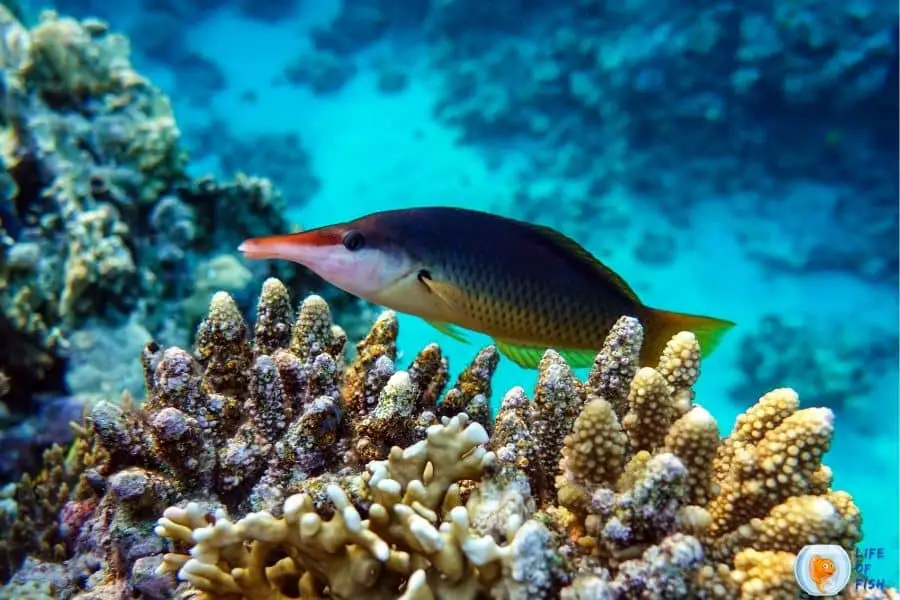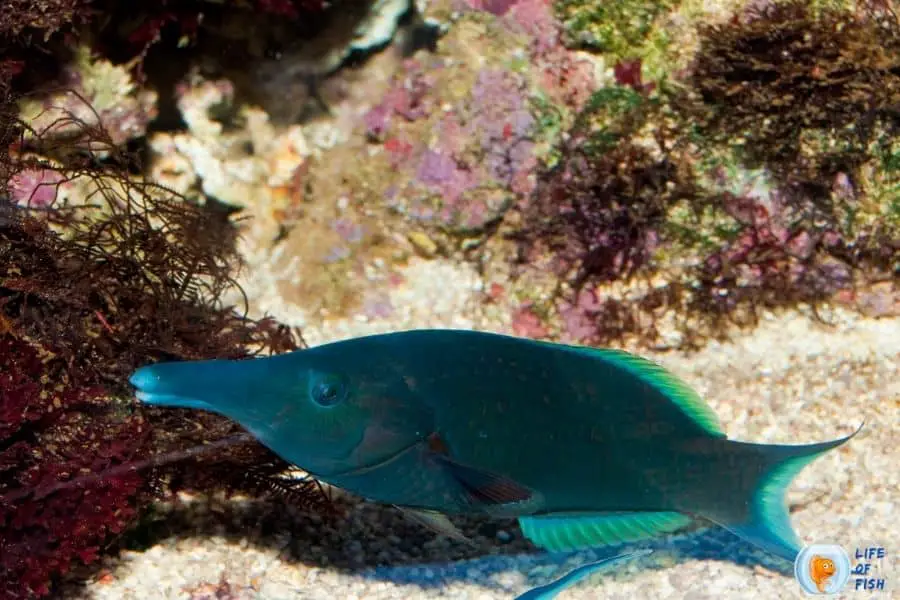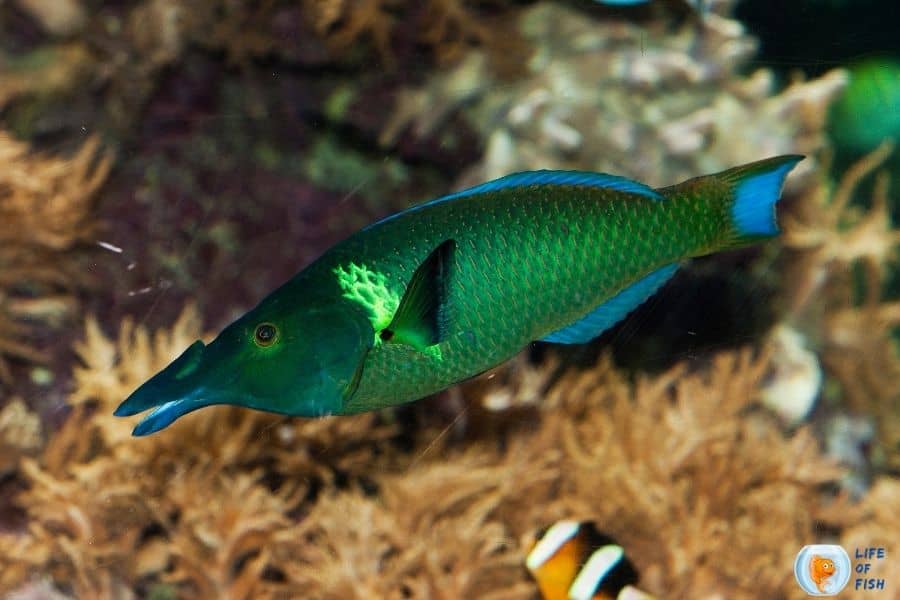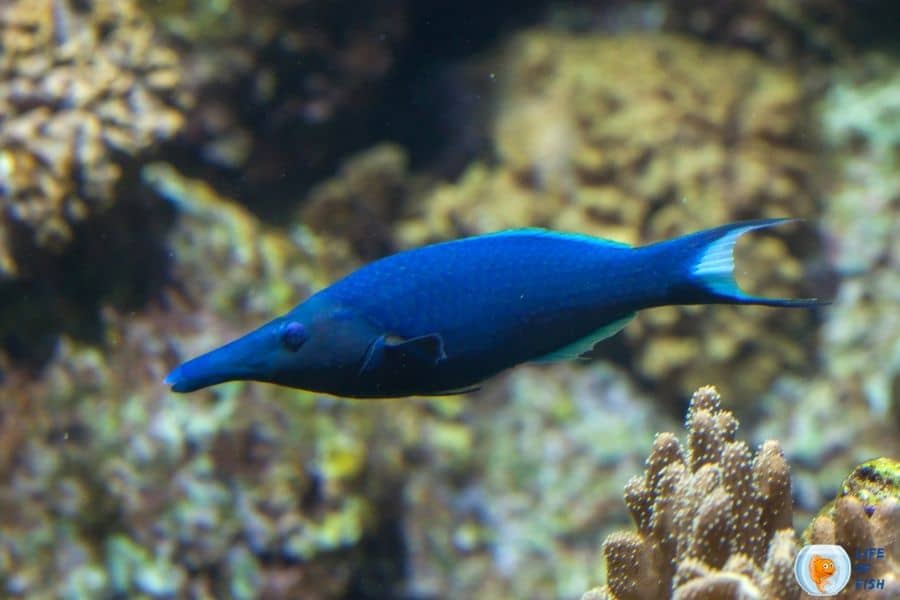Bird wrasse is an unusually shaped, beautiful fish from Labridae family. Being a saltwater fish, this fish is actually beginner-friendly, because of its low requirements in captivity care. Bird wrasse is hardy and disease resistant fish.

However, these fish require a large tank to thrive as they are very active fish. they come in two color morphs, green and black. They are actually the same fish but of different sexes.
One look Care guide
Jump To
- 1 One look Care guide
- 2 What is Bird wrasse?
- 3 Habitat and Distribution
- 4 How big do Bird wrasse get?
- 5 Are they aggressive?
- 6 Bird wrasse behavior
- 7 How long do Bird wrasses live?
- 8 Bird wrasse care
- 9 Bird wrasse breeding
- 10 Special tips
- 11 Bird wrasse diet?
- 12 Bird wrasse tank mates?
- 13 Bird Wrasse Diseases
- 14 Related questions
- 15 Conclusion
| Scientific name | Gomphosus various |
| Common name | Green bird wrasse Black bird wrasse Brown bird wrasse |
| Care level | Easy |
| Native to | Indo-Pacific ocean |
| Type | Saltwater fish |
| Color | Male- Emerald green, Female- white with sprinkled black color spots on the back and a brownish mid-body |
| Tank size | 100 gallons |
| Preferred temperature | 72.0 to 83.0°F |
| Other water parameters (ammonia, etc.) | pH level: 8.1-8.4 pHHardness: 8-12 dKH Specific gravity: 1.020-1.025 SG |
| Preferred salinity | 32.5ppt |
| Size | 12 inches |
| Life Span | Unknown |
| Temperament | Semi-aggressive |
| Recommended tank mates | Fish larger than 3 inches |
| Preferred food | Carnivore, live food |
| Feeding frequency | Several times per day |
| breeding | Unknown in captivity |
What is Bird wrasse?
Bird wrasse (Gomphosus various) is a fish belonging to the family Labridae. These fish are often found in coral reefs in the Indian ocean, but they are also found in the Pacific ocean. They are very hardy fish that can adapt to various water conditions. Hence it is recommended for beginner aquarists.
Appearance-wise, there are two color varieties of these fish. The emerald green color form, called green bird wrasse, is the male specimen, while the white form with sprinkled black color spots on the back and a brownish mid-body, called black bird wrasse, is the female specimen.
They are well known for their unusual beak-like snout, elongated body that is laterally compressed, and truncated tail. These wrasses look like birds, hence the name. Although adult fish are extremely easy to identify, juveniles are not because their characteristics are similar to other wrasse juveniles.
Explore the fascinating world of wrasse fish and learn about their unique characteristics and behaviors!” – wrasse fish
Habitat and Distribution
They are found in the open waters of both tropical and subtropical regions, from low tide zone to coral reefs. They are found in the Indian and Pacific oceans. Since they are commonly seen in these waters, they are listed in the IUCN Red List as Least Concerned species.
How big do Bird wrasse get?
They are medium-sized fish that reach about 12 inches when fully grown. These wrasses can grow to 15 inches, but it is very rare for them to get their full length.
Are they aggressive?
They are semi-aggressive fish that become aggressive toward their prey while showing passive behavior to fish that are not small enough to fit in their mouths. Since their mouths are small, they can only eat tiny fish and invertebrates, so most small fish species will be able to cohabit with these fish if they are fully grown.
Bird wrasse behavior
They are diurnal fish species that often stay in solitary, sometimes in small groups. The ones who prefer solitary are often aggressive and territorial, so it will not be easy for other fish to cohabit with these fish. When they stay in groups, they are often peaceful and won’t bother other fish species. They are usually bottom-dwelling fish, but they can swim around all parts of the aquarium.
They are carnivores, feed mainly on crustaceans and small fish. In the wild, these wrasses are quick hunters who ambush their prey by quickly darting into their prey and swallowing them whole. The fish will often swim close to the reef during nighttime, feeding on invertebrates on the reef. On some occasions, these fish will stay in the same spot for days as they wait for their prey to come by.
They are generally an active fish species, but they can become shy when introduced to a new fish tank.
When large specimens are introduced to a new tank, they often stay hidden and do not eat for a few days. While this behavior can be alarming, it is normal behavior. So, if you are a beginner aquarist, we recommend buying juvenile specimens rather than fully grown ones as they easily adjust to new environments.

How long do Bird wrasses live?
The average lifespan of these fish is about 3 to 5 years in captivity. How long these fish will live in the wild is still unknown.
Bird wrasse care
They are generally easy to care for when given a large fish tank. However, these fish are escape artists. Therefore, it is a MUST to keep your tank well covered.
- Size
They can reach up to 12 inches (30 cm) when fully grown. However, it is very rare for these fish to reach their full length because they usually die before becoming adults. The average size of these fish in captivity is 6-7 inches (15 cm).
tank size
As this fish is relatively large for aquariums, they need a tank size of at least 75 gallons (285 liters) for their initial stage. After getting the fish, look into upgrading to a larger tank if necessary. The minimum tank size for an adult specimen is about 100 gallons (380 liters). These fish require a lot of space due to their large size and active nature. These wrasses like swimming around and exploring, so make sure you provide them with enough space to make them comfortable.
- How many should be kept together?
You can keep them as a singular fish or a group of fish. However, the tank requirement dramatically increases if you intend to keep more than one fish. For a fish pair, you will need a tank of over 150 gallons. For a group of 3 fish, a 200-gallon tank would suffice. When keeping a group of wrasse, you should be extremely careful to put only one male specimen because two male fish will quickly fight to the death over the female. It is okay to keep more than one female fish together with one male fish.
Tank setup
They loves to move around during the day. To fulfill their need for constant movement, you will have to provide a larger fish tank of at least 100 gallons for one fish. The tank should be longer than 6 feet as these fish are fast-moving fish. If kept in shorter tanks, these fish may injure themselves by hitting the rocks and glass all the time.
Substrate
Wrasse is known to bury themselves in the sand in their natural habitats. Most aquarium wrasse species do not show this behavior, but some may inherit the behavior from local Halichoeres. Therefore, it is wise to add sand as the substrate in your aquarium.
Decorations
As we said before, newly introduced specimens may show skittish behavior. So, it is essential to provide plenty of hiding spaces and cover for these fish. While we don’t recommend rocks because of the risk of injury, you can use wood and rock structures to create hiding places for the fish. Plants are also an excellent option to provide hiding places for wrasse. However, it is essential to note that some wrasse species may dig and destroy your plants if they have the chance.
If you are a more experienced aquarist, you can also add some corals into your fish tank, and your fish will appreciate it.
Lighting and filtration
They are not fussy when it comes to lighting, but they are picky when it comes to filtration. These wrasses are known for being fussy eaters, and some are even picky about what they eat at times. These fish are often found in clear water, requiring sufficient lighting to see their prey clearly.
Use of power filters is not recommended when keeping wrasse. Some wrasse species may be okay with it, but others may get sucked into the filter and end up injured or dead.
Water movement
They require well-oxygenated water with a strong water flow. Therefore, in addition to your filtration system, you will need to invest in other water flow devices such as powerheads. Wavemakers for creating waves are also highly recommended if you want to keep these fish in your tank.
Tank Lid
In addition to all other decorations and equipment, you must have a well-covered tank lid. With being so active, these fish are at risk of jumping out of the tank if you don’t have a tight-fitting lid on your tank.
Water quality condition
This fish originates from tropical regions. The water temperature should be kept at 72.0 to 83.0° degrees Fahrenheit, with a specific gravity of 1.020-1.025 SG. The water pH range should be around pH 8.1-8.4 while the water hardness of around 8-12 dKH.
These fish are very hardy and disease-free. Keeping them would be no problem as long as you keep the water conditions up to par. Like other fish, water changes are very important for these wrasses as well. These fishes also produce waste and require water changes to maintain good water quality for them. However, a monthly 20% to 30% water change would be sufficient if you have a much larger aquarium.

Bird wrasse breeding
- Male or female identification
Identifying male and female fish is extremely easy because these fish show sexual dimorphism. The emerald green color wrasse is the male specimen, while the black fish is the female specimen. The female specimen is white with fine black spots, and it has a more blackish or brownish color on the backside. The females are also smaller than the males.
Interestingly, they also undergoes a sexual metamorphosis, which means they change their gender from female to male when necessary. All wrasse are born females, but the female specimen can change their gender to male when the social hierarchy of wrasse species is disrupted.
Bird wrasse breeding
Their breeding in captivity is unknown. It is believed that these fish need a much larger tank of at least 300 gallons for spawning. One aquarist actually had a mating-like experience with his wrasse pair kept in a 300-gallon tank. However, whether he ended up with fish fry or not is still unknown.
The male and female were seen running in and out of the rockwork with their top fin fully erected. They halted near the top of the tank, made contact in some manner, generated gametes as a little white cloud, and then darted away.
- How many babies do Bird wrasse have?
Wrasse species lay between 1,000 and 5,000 eggs at a time. So, we can expect the same amount of fries from them too.
Special tips
If you want a wrasse pair, you can simply buy two juveniles or two female wrasses. It will be cheaper, and the dominant fish will eventually become a male specimen. While these fish do fine with some reefs in the aquarium, they are not compatible with reef-only aquariums. They will most likely eat any fish that is too small for them to swallow. So, do not add any small fish to your wrasse tank if you want them to live.
Bird wrasse diet?
They are carnivores, and they eat mostly live food, but there are reports of some captive specimens that eat frozen food as well. These fish mainly eat all kinds of crustaceans, echinoderms, mollusks, and other invertebrates. They don’t eat algae, but they will rummage through algae looking for copepods that may be hiding there. They eat any living crustaceans, echinoderms, and other invertebrates in the aquarium. Some aquarists report that these fish do fine with small feeder shrimps as well.
Some foods you can give to your fish are,
Brine shrimp - Mysis shrimp
- Shrimp flesh
- Shaved fish
- Fish flake
- Squid and
- Mussels
You can also provide a variety of frozen food and marine pellet food to your fish to check if they eat everything. If your fish avoids eating frozen food, you can try tricking them by feeding them pieces of fresh or raw foods. This is a common practice that all aquarists do to feed their fish with frozen food.
These fish usually eat anything that moves around if that fits their mouth. So, you can make your frozen food move by using a stick. This will make your frozen food seem like live food, and your fish may start eating it.
- Feeding frequency
They needs several feedings per day as these fish are always active. They need at least 2 to 3 feedings per day, so do not miss out on any of them.

Bird wrasse tank mates?
They can live in the same species tank as well as a community tank. However, you should be careful not to add any fish smaller than 3 inches. They are great in a predatory saltwater tank as well.
- Same species
They can live with the same species of fish. However, one tank should only contain one male fish. Otherwise, these fish may fight among themselves until death. You can keep one or more female fish with one male fish, but the tank must have a capacity of at least 200 gallons. The tank should be well decorated with rocks, caves, and other hiding areas for the fish to claim territories.
Peaceful Community tank
They can live with any community fish that is larger than 3 inches and is not an herbivore. These fish are compatible with other fish that are reef safe, but they will eat smaller fish even if they are not their prey. Some suitable peaceful tank mates are assessors, gobies, dartfish, and fairy wrasses.
Note: You should monitor the aquarium frequently, as this fish may sometimes eat dartfish and fairy wrasses.
Semi-aggressive and aggressive fish
They do very well with semi-aggressive and aggressive fish. Because of their semi-aggressive behavior, they can defend themselves if an aggressive fish bully them. Further, these fish won’t bother other fish as long as they are bigger than 3 inches because they can not eat them. Some suitable semi-aggressive tank mates are clownfish, anthias, dwarf angels, tangs, large angels, and large wrasses. Some suitable aggressive tank mates are dottybacks, damselfish, 6-line & 8-line wrasse, groupers, lionfish, and soapfish.
Corals and Anemones
These fish do fine with all types of coral and anemones.
Crustaceans, echinoderms, and other invertebrates
They eat all types of crustaceans, echinoderms, and other invertebrates. However, you should know that they will not turn down feeder shrimps either. So, bird wrasse will be a threat to these creatures in your aquarium. Some creatures you should never cohabit with bird wrasse are,
- shrimps
- crabs
- snails
- starfish
- flatworms
- bristle worms
- feather dusters
- oysters
- scallops and
- clams
Bird Wrasse Diseases
One of the best characteristics of this fish is that these fish are disease resistant. In fact, they don’t get infected with any disease other than parasitic diseases. Still, they are easy to treat with typical aquarium medication. You will have to keep the sick fish in a quarantine tank to cure the fish. Further, you can also treat your fish with a freshwater treatment. However, you will have to ensure that your fish is not stressed out because of the freshwater bath.
These fish are timid. So, stress is the number 1 killer of these fish. You need to make sure that other tank mates or you do not stress out your fish. You can do this by providing them with a lot of hiding places in the aquarium.
Related questions
Are Bird wrasses rare?
They are not rare and widespread around the Indo-Pacific area in the wild. Any LFS (local fish store) would have them in stock, and they are not pricey either. In fact, they are quite cheap when compared to other saltwater fish in the market.
How long does a Bird wrasse live?
The exact lifespan of them is unknown. However, they tend to live about 3 to 5 years in captivity.
Conclusion
Bird wrasse is an excellent beginner-friendly saltwater fish because of its hardiness and disease-free nature. They also make a wonderful addition to your community tank if other fish are not small enough for them to eat. However, their feeding requirement makes them somehow challenging to care for as they need live food. Still, they can be great pets if you can provide for their needs.
Read Next : Moon Wrasse or Lunare Wrasse A Beautiful And Magical Fish Red Coris Wrasse Ultimate Care Guide

